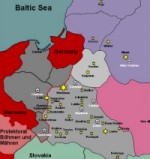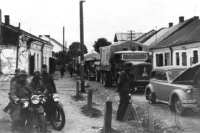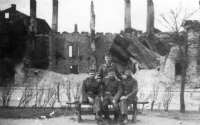 |
 |
 |
 |
 |
 |
 |
It is uncertain when Jews first settled in Radomsko, but in 1643, the Polish King Wladyslaw IV excluded them from living in the city. They were only officially permitted to return in 1862. During the period they were prohibited from residing in Radomsko, the Jews lived in the nearby village of Bugaj. Jews from Bugaj who carried out commercial activities in Radomsko were required to leave the city in the evening. Bugaj was annexed by the city of Radomsko at the beginning of the 19th century, at which time a Synagogue Committee was organized, the first Jewish institution in Radomsko. The Jewish population grew rapidly from the mid-19th century onwards, and by the eve of WW2, when the overall population numbered approximately 25,000, about 10,000 of them were Jews.
 |
| German Invaders #1 |
 |
| German Invaders #2 |
On 20 December 1939, Radomsko became the second city in Poland to have a ghetto established, situated on Szkolna, Stodolna, Joselwicza, Strzalkowska, Fabianiego, and Mickiewicza Streets. A sign was placed at the entrances to the ghetto, reading: "This is the ghetto. Entering is strictly forbidden. For Jews, leaving the ghetto without the permission of the city commandant is strictly forbidden." The Judenrat was created on 15 November 1939 under the chairmanship of Mojsze Berger, later succeeded by Wiktor Gutsztat. Now a Jewish police force was also formed under the command of Natan Winer.
German extortion occurred on a grand scale. Apart from money and valuables, furniture, clothing, linen, bedding, musical instruments and the furnishing of a brothel for Wehrmacht use were demanded. The Judenrat obtained many of the goods by purchasing them from Polish merchants.
In early June 1940, Jews from Lodz, Ozorkow and Zdunska Wola were transported to the ghetto. At the end of June 1941 the Germans decreased the size of the ghetto, intensifying the already unbearable overcrowding. Nevertheless, during 1942 still more Jews from surrounding towns and villages such as Amstow, Plawno, Gidziel, Kamiensk, Kodran, Mojslawice, Strzalkow, and Klomnice were transported to the ghetto.
Throughout its existence, many people died in the ghetto as a result of typhus and other epidemics, malnutrition and the exhaustion caused by intolerably harsh working conditions. In August 1941, the Judenrat were forced to select 200 young men for forced labour at Plaszow, from where a few of them returned in November of that year. Through the initiative of a group of Jewish women headed by Dora Rozenboim, an orphanage housing 60 children aged 3-6 was established in January 1942.
On one occasion a group of German journalists appeared in the ghetto. Jews were posed in compromising positions for photographs that later appeared in German magazines. The photographs were intended to give the impression that the Jews of Radomsko were degenerate members of the underworld, living a life of ease and plenty. In truth, in places like the Gidziel labour camp close to Radomsko and elsewhere, the Germans diligently carried out the practice of annihilation through work.
A courier had arrived in Radomsko in July 1942 from the Warsaw Ghetto. He bore the terrible news that the Jews of Warsaw were being murdered in Treblinka. As in other places, the news was greeted with disbelief by some and terror by others. A number of Jews began to prepare hiding places in cellars and attics. On 9 October 1942, the ghetto having been sealed, a large scale Aktion began. The Germans in charge of the Aktion, Feucht and Kempenik, produced a list of 350 Jews who had permission to remain in the ghetto; these included members of the Judenrat, the police, some doctors , dentists and certain skilled workers.
Between 10–12 October 1942, 14,000 Jews were transported from Radomsko to Treblinka in two transports. Hundreds of others had been shot in the ghetto itself in the course of the roundup. Included in the second transport were 29 of the 350 persons originally allowed to remain in the ghetto. There were thus 321 Jews officially remaining in the city, although many more were in hiding. The 321 "legal" Jews were packed into four houses on Mickiewicza Street.
Some messages thrown from the railway cars en route to Treblinka were brought to the ghetto by the Poles who had found them. One of these was a letter that was written by Bela Yoistman (Justman?) to her husband Dovid:
"My dear Dovid! It is before dawn and I am travelling in a crowded cattle car in the direction of Treblinka; I travel to a certain death. You, Dovid, see that you save yourself, while I am already in the enemies' hands. I am already lost. Forget me and love again with happiness! Fate wanted it this way. Stay healthy dear husband and give my sincere regards to your sister and brother-in-law."
The person to whom the letter was addressed, Dovid Yoistman (Justman?), did not receive it. He had been sent to Treblinka in the first Aktion.
At the end of October 1942, the Germans announced the creation of four "Jewish cities" in the district Radom - Ujazd, Sandomierz (Tsuzmir), Szydlowiec and Radomsko. Jews from surrounding areas arrived in Radomsko and many of those in hiding joined them, lured by false promises of safety. The Germans assured members of Zionist youth groups in the city that they were to be exchanged for German nationals interned in Palestine (a commonly practiced deception). But the chairman of the Judenrat, Gutsztat, warned them that this was "another Gestapo trick" and urged them to flee, which many did.
Soon the small ghetto contained 4,500 people. Overcrowding was worse than ever, with an average of fifteen to twenty people living in one room. At first the residents of the ghetto thought that the transports had ceased, but the reprieve was temporary. On 6 January 1943, the Jews were driven to the Umschlagplatz. The younger ones, among them the entire Jewish police force, were sent to the Skarzysko-Kamienna labour camp, where earlier small transports had also been sent. All others, numbering approximately 4,000 individuals, were transported to Treblinka. 29 people were left to clean the ghetto and maintain housing. Later further Jews were added to this group until it totalled 41 people. The Germans estimated that about 800 Jews were still missing. As these were recaptured, they were taken to the Jewish cemetery and shot. After months of hardship and suffering, the last remnants of the Jews of Radomsko were sent to the Pionki labour camp on 21 July 1943.
Trial:
Augsburg, 1949
Zipser, Heinz - 6 years
(Zivilverwaltung Landratsamt Radomsko (Kreis- und Stadtbauamt)
Crime committed in Radomsko, Poland in 1939 - Mishandling of Jewish forced labourers, resulting in the death of one of them.
SOURCES:
Gilbert, Martin. The Holocaust – The Jewish Tragedy, William Collins Sons & Co. Limited, London, 1986
Gilbert, Martin. Atlas of the Holocaust, William Morrow and Company Inc, New York, 1993
Arad, Yitzhak. Belzec, Sobibor, Treblinka - The Operation Reinhard Death Camps, Indiana University Press, Bloomington and Indianapolis, 1987
Karay, Felicja. Death Comes in Yellow – Skarzysko-Kamienna Slave Labour Camp, Harwood Academic Publishers, The Netherlands, etc., 1997
www.jewishgen.org/yizkor
www1.jur.uva.nl/junsv/index.htm
 |
| 20,000 Jews lived in the ghetto |
© ARC 2005